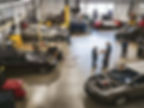Shocks, Struts & Suspension Repair

⚑ Complete Service For All Suspension Repair Problems

⛍ Our Expert Suspension Services

⚑ Get Your Suspension Repair Done Right — Book Your Appointment Now!

⚑ Expert Suspension Repair Shops Near You


⚑ Close to Steeles Ave & Torbram Rd Brampton, ON L6T 1A7
✰✰✰✰✰4.8 star rating

⚑ Just off Appleby Line & Corporate Dr Burlington, ON L7L 5T9
✰✰✰✰✰4.9 star rating

⚑ Nearby Burnhamthorpe Rd & Kipling Ave Etobicoke, ON M8Z 2X3
✰✰✰✰✰4.8 star rating

⚑ Near Mohawk Rd & Upper Sherman Ave Hamilton, ON L8V 4G7
✰✰✰✰✰4.6 star rating

⚑ Near Matheson Blvd & Hurontario St Mississauga, ON L4Z 2Y5
✰✰✰✰✰4.4 star rating

⚑ Close to Finch Ave & Weston Rd North York, ON M9M 2Y3
✰✰✰✰✰4.5 star rating

⚑ Right by Howard Park Ave & Bloor St Toronto, ON M6R 1V5
✰✰✰✰✰4.7 star rating
💬 Suspension Service: FAQs

Should I replace one suspension component, shock, strut, spring, or both sides?

Suspension components (ball joints, control arms, sway bar links, tie rod ends): Can be replaced individually if only one is worn, but replacing parts in pairs (front or rear) ensures balanced handling and consistent ride quality.
Shocks and struts: While replacing just one may work short-term, for optimal comfort and stability, it’s recommended to replace both front or both rear shocks/struts together.
Springs: Always replace both springs on the same axle at the same time to maintain symmetry, uniform performance, and safe handling.
How much does a suspension repair cost for shocks and struts replacement?

Costs vary depending on your vehicle’s make and model, the parts being replaced, and labor rates. Typically, replacing one shock or strut can cost around $300–$1,500. Getting a detailed estimate from our certified mechanics is recommended.
What are the main components for suspension repair?

Shocks, struts, springs, control arms, sway bar links, ball joints, tie rod ends, and bushings make up the primary suspension components which generally require a replacement part if worn or damaged.
What's the difference between shocks & struts replacement?

Shocks control the up-and-down motion of your vehicle, smoothing bumps and maintaining tire contact, while struts provide structural support for the suspension system, supporting weight and handling. Both can wear out over time, causing a harsh ride or poor handling. Replacing worn shocks or struts restores stability, ride comfort, and proper suspension function.
How often should I replace my shocks / struts?

Generally, shocks & struts replacement is recommended every 50,000–100,000 km, but inspect them sooner if symptoms of wear appear.
What happens if I ignore a suspension repair?

Ignoring a suspension repair issue can lead to unsafe driving conditions, including reduced control, poor handling, uneven tire wear. It can also cause further damage to other vehicle components, leading to higher repair costs.


